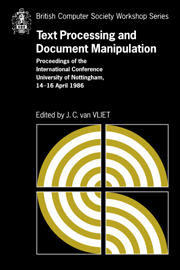 Text Processing and Document Manipulation
Text Processing and Document Manipulation Book contents
- Frontmatter
- Contents
- Preface
- The Design of Lucida®: an Integrated Family of Types for Electronic Literacy
- Tabular Typography
- A Simple Mechanism for Authorship of Dynamic Documents
- VORTEXT: VictORias TEXT reading and authoring system
- An Approach to the Design of a Page Description Language
- Intelligent Matching and Retrieval for Electronic Document Manipulation
- A Disciplined Text Environment
- Semantic Guided Editing: A Case Study On Genetic Manipulations
- Trends and Standards in Document Representation
- Textmaster – document filing and retrieval using ODA
- Combining Interactive Document Editing with Batch Document Formatting
- Formatting Structure Documents: Batch versus Interactive?
- Advanced Catalogue Production at Unipart
- Legibility of Digital Type-fonts and Comprehension in Reading
- An Overview of the W Document Preparation System
- Grif: An Interactive System for Structured Document Manipulation
- Procedural Page Description Languages
- A Strategy for Compressed Storage and Retrieval of Documents
- CONCEPT BROWSER: a System for Interactive Creation of Dynamic Documentation
- An Integrated, but not Exact-Representation, Editor/Formatter
- An Annotated Bibliography on Document Processing
- Systems used
CONCEPT BROWSER: a System for Interactive Creation of Dynamic Documentation
Published online by Cambridge University Press: 05 May 2010
- Frontmatter
- Contents
- Preface
- The Design of Lucida®: an Integrated Family of Types for Electronic Literacy
- Tabular Typography
- A Simple Mechanism for Authorship of Dynamic Documents
- VORTEXT: VictORias TEXT reading and authoring system
- An Approach to the Design of a Page Description Language
- Intelligent Matching and Retrieval for Electronic Document Manipulation
- A Disciplined Text Environment
- Semantic Guided Editing: A Case Study On Genetic Manipulations
- Trends and Standards in Document Representation
- Textmaster – document filing and retrieval using ODA
- Combining Interactive Document Editing with Batch Document Formatting
- Formatting Structure Documents: Batch versus Interactive?
- Advanced Catalogue Production at Unipart
- Legibility of Digital Type-fonts and Comprehension in Reading
- An Overview of the W Document Preparation System
- Grif: An Interactive System for Structured Document Manipulation
- Procedural Page Description Languages
- A Strategy for Compressed Storage and Retrieval of Documents
- CONCEPT BROWSER: a System for Interactive Creation of Dynamic Documentation
- An Integrated, but not Exact-Representation, Editor/Formatter
- An Annotated Bibliography on Document Processing
- Systems used
Summary
ABSTRACT
In this paper, a system for interactive creation and browsing of dynamic documents is described. The Concept Browser allows the user to create a semantic network of interrelated concepts and interactively navigate through the network. Outlines and printed documents can be automatically generated from the network of concepts. The Concept Browser has been designed and implemented in a Smalltalk programming environment. An interactive, window-based user interface is provided that allows the user to browse through and modify the network of concepts.
Possible applications for the Concept Browser are in the areas of on line documentation, tutorial systems, document preparation systems and electronic books.
Introduction
The traditional method of storing information in a printed, linear form as it is done with conventional books has been demonstrated to be inadequate both to represent the complexity of information and to offer quick and flexible access to it [8].
The personal computer appears to be the ideal tool to satisfy these requirements, but a simple computer-based transcription of traditional books is not the best way of taking advantage of the new functionalities offered by computers.
The purpose of this article is to describe one experiment in the design of a documentation system that can take advantage of the flexible data structures and advanced user interface provided by a Smalltalk programming environment.
A semantic network was chosen as the best way of representing the complexity of information ([4],[6]) instead of a more traditional tree structure [5].
- Type
- Chapter
- Information
- Text Processing and Document ManipulationProceedings of the International Conference, University of Nottingham, 14-16 April 1986, pp. 233 - 245Publisher: Cambridge University PressPrint publication year: 1986


